Two more eyewitness accounts of Capa’s presence on and departure from Omaha Beach on the morning of D-Day have come to light.
The first has as its author Charles Hangsterfer, “Colonel, U.S. Army (Ret). Battalion HQ Company Commander and Battalion Adjutant of the 1st Bn., 16th Inf. Regiment., 1st Division, … [who also] took care of administration for the battalion.” This provides some confirmation of our hypothesis that Capa came in with regimental HQ, not with an assault team. Combined with the visual evidence (from Capa’s first five photos ) that he came in with soldiers carrying HQ supplies and not small arms, mortars, machine guns, and such, this starts to look persuasive. (Click on the images below to enlarge them.)
The short version of Hangsterfer’s story, “D-Day Reflections From A Soldier,” takes the form of a previously unpublished memoir that his daughter Peggie Walsh put up at the Huffington Post “unedited” on June 6, 2014, the 70th anniversary of that battle. Given his reference therein to Capa as “Bob,” this memoir suggests that Hangsterfer knew Capa, at least in passing. That gets confirmed in a lengthy oral-history interview with Hangsterfer conducted on October 28, 2004 by Michael Straubel, a student at Gettysburg College, in whose Special Collection this interview resides. (Click on the link above for a complete pdf download of the transcript, easier to read than the online version.)
In a nutshell, Hangsterfer recalled that his contingent landed on Easy Red at H+30 (0700). He made it through the surf and onto the beach, then scrambled up the bluff to the top, where he shared an apple and a shot of scotch with one “Major Smith,” after which he headed back down to the beach to round up the rest of his company in order to get them off the beach and moving inland.
“When I got back on the beach I saw Bob Capa, a combat photographer for a magazine taking pictures of the carnage. He was behind one of the self-propelled tanks which had been knocked out,” Hangsterfer wrote. (Most likely the “Amphibious Armored Vehicle” No. 10 visible in several of Capa’s images.) In the oral-history interview, he elaborated:
HANGSTERFER: [T]hen I had to go back onto the beach to find out where the rest of my company was, we had a couple boat loads and I went back on the beach to find them. As I was walking down the beach — you know, finding them, looking, prodding people, some of them were dead, and some of them they weren’t my outfit — I saw Bob Capa. You ever hear of Bob Capa?
STRAUBEL: No.
HANGSTERFER: He was a photographer and I never could understand why anybody would want to [inaudible] … He was a civilian, he was paid to take pictures and he was behind this — one of these DD tanks that was knocked out. There were three of them out of a hundred, these DD tanks I started to tell you about, these tanks that were supposed to be our artillery support, and three of them got to shore out of a hundred and he was behind one of them, knocked out [inaudible] on the beach … taking pictures and I waved to him. I had seen him over in North Africa and he knew who I was and he took a picture of me, but the poor guy took all these pictures and none of them turned out … Somebody goofed up in the development of them and they never turned out. So I never had a picture of me on the beach there looking for my troopers, but they got off, they were trained guys and there was another pathway off so they got off. They didn’t have to go through the water like I had to go through, but they got off and we got up on top of the hill. [Thanks to Rob McElroy for checking the online transcript against the online audio of this interview and ensuring the accuracy of the above passage. — A. D. C.]
By my estimate, all that had to have taken Hangsterfer somewhere between 35-50 minutes — which would mean that he saw Capa somewhere between 07:35 and 07:50. That matches up with the arrival of LCI(L)-94 at 07:47 and Capa’s decision to board it and get the hell out.
If Capa was that far behind Hangsterfer, it indicates that he came in well after him, with the rear echelon of Battalion HQ. If Hangsterfer could reach and cross the beach, ascend to the top of the bluff, take time there for a snack and a snort, clamber back down to the beach, make himself conspicuous to any enemy by waving to Capa from the beach, and walk around gathering his troops, it also signifies that enemy fire had eased considerably by then. Hiding in the surf behind the assault vehicle as Capa did therefore represented just one option at that juncture. The battle had already begun to move off the beach and up the ridge; Capa could have followed the action and gone along. After all, that’s why LIFE had given him this highly coveted front seat. He took a different course.
•
 The narrative of the second “new” eyewitness, the late Victor Haboush (1924-2009), comes to us at one remove, which doesn’t strike me as affecting its credibility. After serving in the U.S. Coast Guard during World War II (which brought him to Omaha Beach on D-Day), Haboush began his career working on storyboards and illustrating children’s books for the Disney Studios, eventually going independent and directing over 1500 TV commercials. (Click here for a tribute from his friend and colleague Amid Amidi at Cartoon Brew, which includes biographical details, published on August 5, 2009.)
The narrative of the second “new” eyewitness, the late Victor Haboush (1924-2009), comes to us at one remove, which doesn’t strike me as affecting its credibility. After serving in the U.S. Coast Guard during World War II (which brought him to Omaha Beach on D-Day), Haboush began his career working on storyboards and illustrating children’s books for the Disney Studios, eventually going independent and directing over 1500 TV commercials. (Click here for a tribute from his friend and colleague Amid Amidi at Cartoon Brew, which includes biographical details, published on August 5, 2009.)
On June 6, 1944 Haboush served with the crew aboard LCI(L)-94, the landing craft that brought medics in to Easy Red and evacuated the wounded, and on which Capa made his escape from the battlefield. Haboush appears in several of Capa’s 2-1/4″ Rolleiflex images of medics tending the casualties, including the one published in LIFE. (In the comments evoked by Amidi’s commemoration of Haboush, the descendants of a number of other soldiers clustered in that image identify their parents. Another commenter reports that Haboush “had this Capa photo from Life framed on his wall.”)
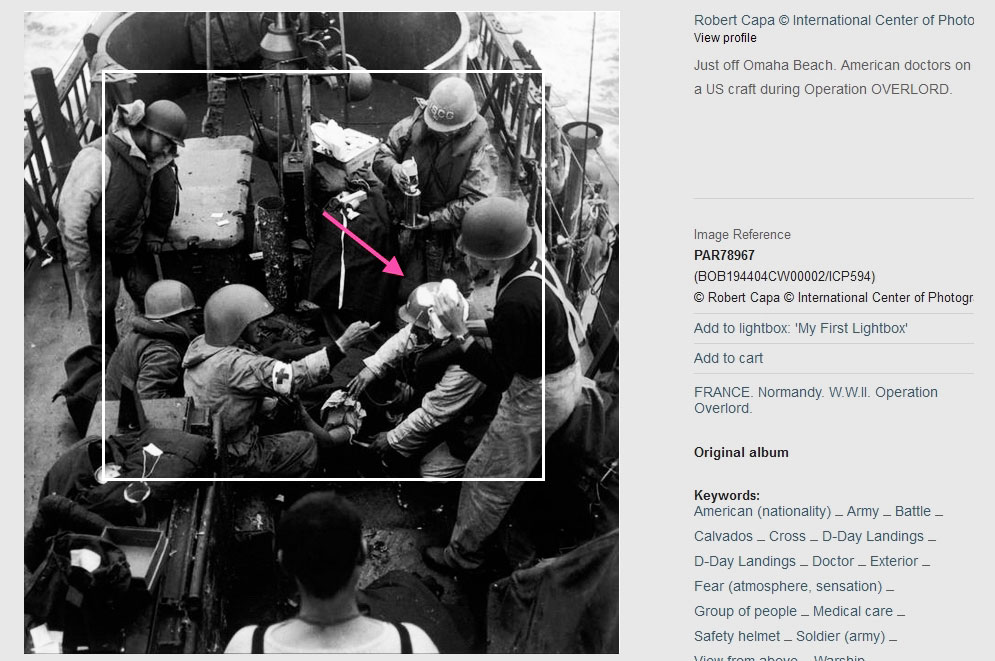
Robert Capa, “Untitled (Medics at Omaha Beach, June 6, 1944).” Annotated screenshot from magnumphotos.com. Victor Haboush indicated by red arrow.
Kevin O’Brien, a story artist at Pixar Animation Studios (best known for his work on The Incredibles, Ratatouille and WALL-E, but also involved in 35 episodes of The Simpsons and five of Futurama, one of which he directed), worked with Haboush on the 1999 animated film The Iron Giant. In his comment, he writes,
“I consider myself privileged to have known and to have worked with Victor on Iron Giant. I really enjoyed him and loved his work and enthusiasm. Being a history buff, I was fascinated by his first hand account of being in the second wave at Omaha beach. He said his LCI (landing craft) hit the shore while there was still a lot of shooting going on. A soldier ran towards their boat, and Victor’s skipper raised a Thompson submachine gun at the guy, which was an accepted procedure. Soldiers were only supposed to move in one direction, inland. The soldier stopped, turned and frantically pointed to his shoulder patch, identifying him as a correspondent. He was let on the boat, and almost immediately Victor’s skipper was hit by something large, a shell fragment, or something. Victor was first to give the man first aid, and Capa reloaded his camera and took pictures. The incident is told from Capa’s POV here.”
O’Brien’s link leads to excerpts from Capa’s 1947 memoir, Slightly Out of Focus. O’Brien goes on to repeat the received version of Capa’s story — coming in with the first wave, losing his negatives in a darkroom accident. Whether that came to him via Haboush or from his own reading is unclear. But Haboush’s narrative of Capa’s arrival at LCI(L)-94, as relayed by O’Brien, correlates exactly with Capa’s own (though Capa omitted the detail of the skipper mistaking him for a deserter), so it seems reliable. If we take it as such, then Capa did indeed climb aboard just after its incoming passengers disembarked, and just before the LCI got shelled, at roughly 07:40.
(O’Brien posted a variant of this comment at the Facebook page “Timeline Photos.” This page includes a “colourised” version of Capa’s negative 35, showing the demolition team at work. Thanx, and a tip of the Coleman hat, to Jim Hughes for pointing me toward O’Brien’s note.)
•
[Postscript, February 21, 2017: O’Brien’s account contains numerous errors, perhaps Haboush’s but possibly his own, the result of retelling a second-hand story heard decades earlier.
No military record for LCI(L)-94’s Capt. Gene R. “Popeye” Gislason — including his headstone at Arlington National Cemetery — lists him as a casualty that day, for which he would have received a Purple Heart in addition to the Silver Star awarded him. Only a Lt. (jg) Mead is recorded as badly wounded aboard LCI(L)-94 on June 6; he was in the pilothouse when it was hit, whereas Gislason would have stationed himself on the open bridge, one deck above. O’Brien also mentions Capa pointing to his correspondent’s patch; Capa did not wear that patch on either his helmet or field jacket on D-Day.
Nonetheless, the ship’s Muster Roll confirms that a Seaman 2d Class Victor Haboush reported aboard the 94 on 18 April 1944. So he was certainy there on D-Day, and Capa’s photo, above, proves that he was there too. My thanks to Charles Herrick for searching the records for these details.
Here’s the relevant passage from Capa’s narrative:
“I reached the boat. The last medics were just getting out. I climbed aboard. I felt a slight shock and I was all covered with feathers. ‘What is this? Is somebody killing chickens?’ Then I saw that the superstructure had been shot away and the feathers were the stuffing from the kapok jackets of the men who were blown up. The skipper was crying because his assistant had been blown all over him and he was a mess.”
Not incidentally, the above facts give the lie to most of this concoction. — A. D. C.]
•
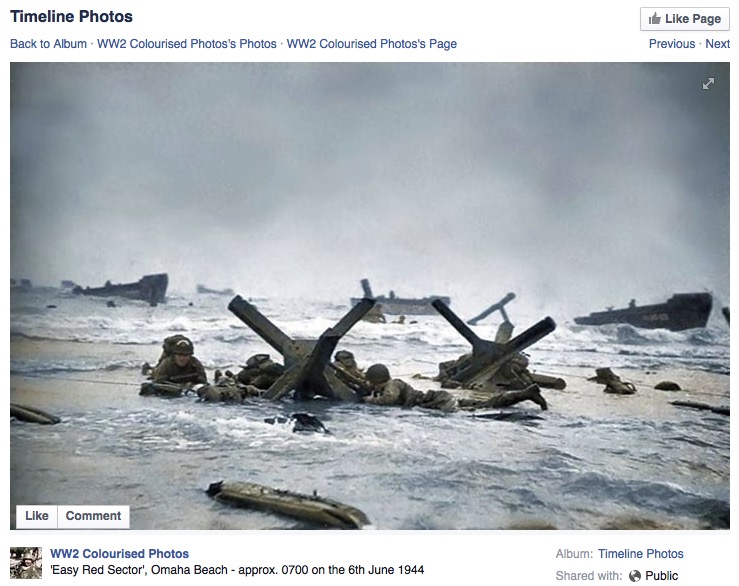
Robert Capa, Omaha Beach exposure 7/negative 35, June 6, 1944, “colourised” by Timeline Photos. Facebook screenshot 7-21-15.
Added to the accounts of Motor Machinist’s Mates Charles Jarreau and Clifford W. Lewis, that gives us three independent yet consistent accounts by crewmembers of Capa boarding LCI(L)-94 shortly after its arrival on Easy Red at 07:47 — surely enough for us to consider this firmly established in the timeline. And if Capa did board LCI(L)-94 just after it came in, that also means he stayed there for another 50 minutes before it departed the beach at 08:37 — giving him ample time to pull himself together and return to fulfilling his assignment. He made a different choice.
So we now have four eyewitnesses to Capa’s presence on Easy Red — three of the crew on LCI(L)-94, plus Hangsterfer. If we add Huston Riley’s story of getting help from Capa and then seeing him run for the LCI, we have five. But the logistics of Riley’s arrival time and landing spot that day put his crossing paths with Capa — and thus his identification as “The Face in the Surf” — in doubt. So, however tempting, we should take his corroboration with a grain of salt. Fortunately, it’s not required at this point; other testimony from people who either recognized Capa or discovered on D-Day that he worked for LIFE suffices.
•
(For an index of links to all posts in this series, click here.)



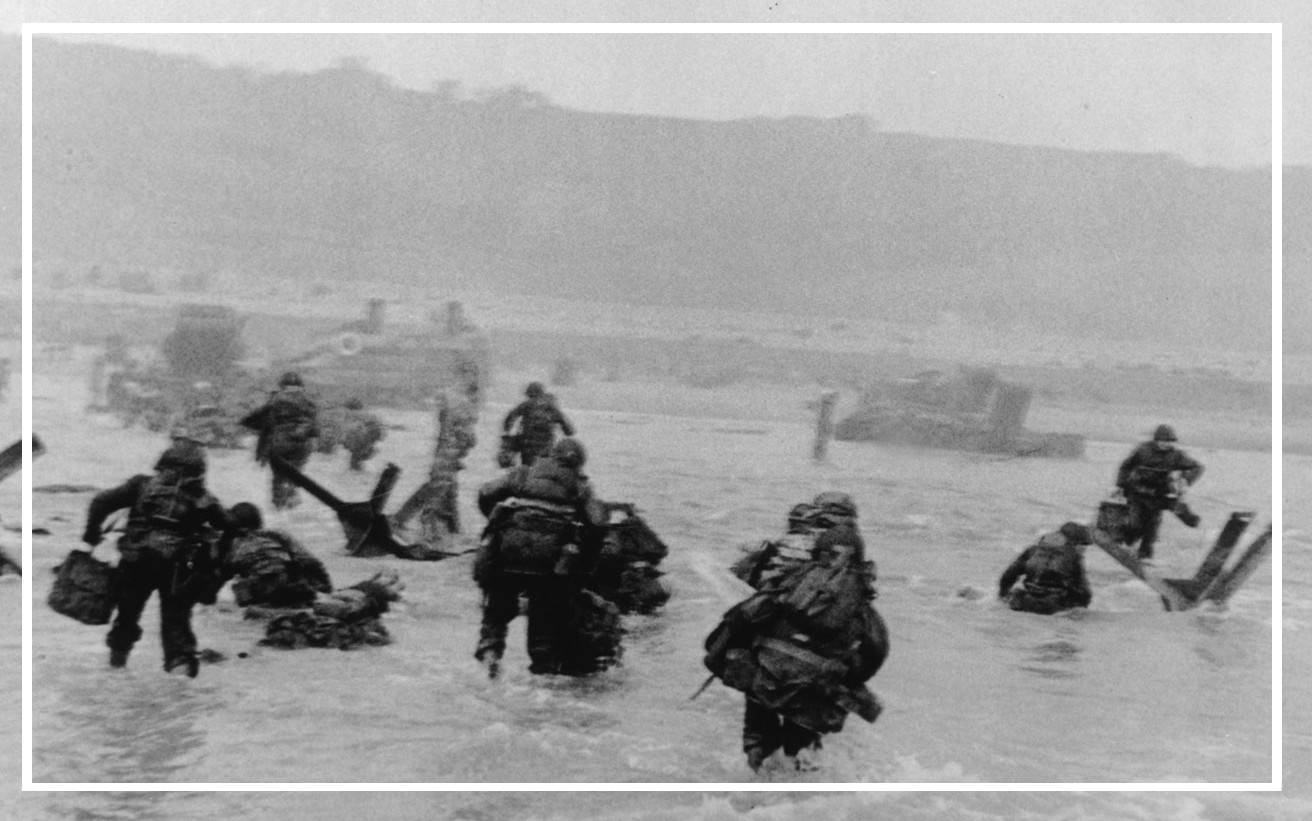
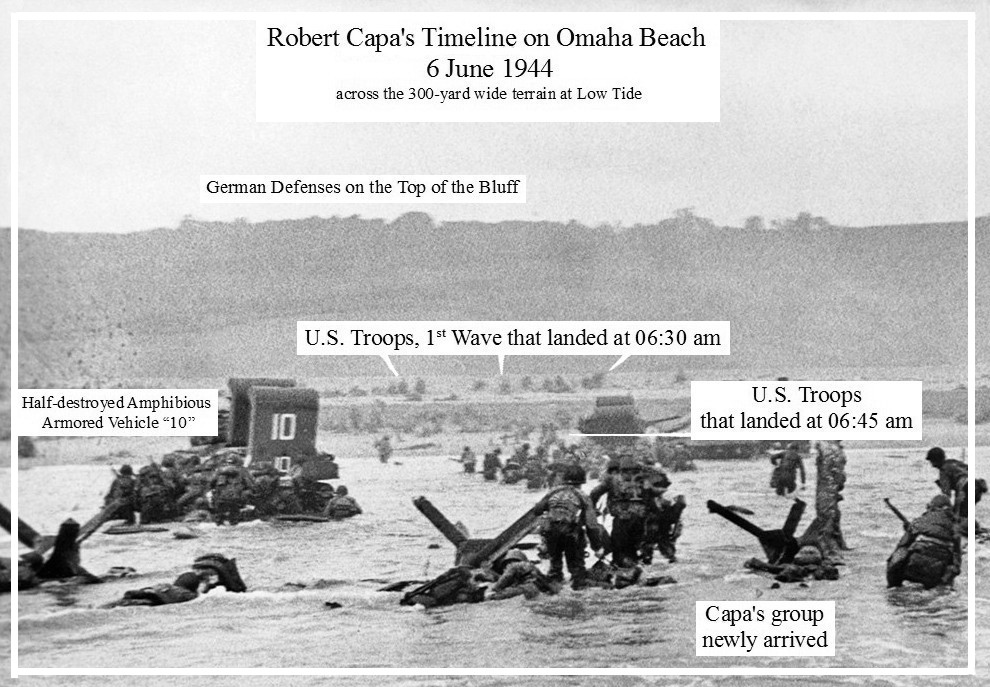
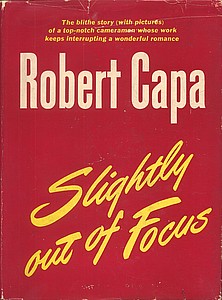
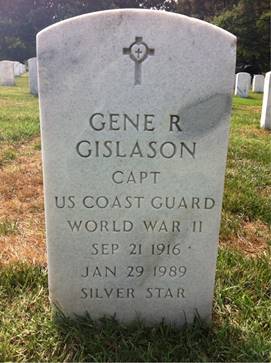




Whilst your looking at dispelling myths have a look at the images that made it that day. There are no darkroom errors that would expose the sprockets on the rebate, either Capa miss loaded or the bulk film canister jammed, thus exposing the sprockets then snapping the film so that non of the frames captured exposed film.
Believe it or not, I have actually “ha[d] a look at the images that made it that day.” I’ve studied both the contact sheets and the negatives themselves, as earlier posts in this series make clear. Only someone ignorant of the content of this research project could suggest otherwise.
The question of the image area overlapping the sprocket holes has received detailed attention and convincing explanation from photo historian Rob McElroy earlier this year.
Familiarizing themselves with our investigation in detail can save commenters both time and embarrassment of this sort. Strongly recommended.
I have no ‘dog in this fight’ as the saying goes, & have enjoyed dipping into your posts. If I’m allowed to make one critical observation – it would be a more forensic approach to acknowledge events that raise questions about your own narrative as keenly as you are to question the official one. Specifically –
“I had seen him over in North Africa and he knew who I was and he took a picture of me”. Here we have an independent eye-witness to a photo that isn’t captured in the ‘surviving’ film.
Now this neither harms nor helps your narrative of a panicked Capa, & can be explained away with various suppositions – but you’re presenting it without comment. Those possible explanations in their turn open up new questions that I believe you could be pursuing as assiduously as those that contribute to your preferred narrative; otherwise this process becomes a crusade after a particular outcome rather than the truth (or possible truths) of what happened that day.
Glad you brought this up. Here are the complexities of and problems with Hangsterfer’s recollection of seeing Capa on Omaha Beach:
* So far as I can determine, he first went on the record with this in 2004, 60 years after D-Day. Contemporaneous accounts, or accounts first offered much closer to the event, carry greater weight.
* We must factor in also the possibility of what I think of as “borrowed glamor” — the tendency of people to incorporate into their personal memories notable personages present and/or things they know happened at an event in which they participated, but that they didn’t actually see. This increases over time. Which explains the basic unreliability of eyewitness testimony and the increasing caution within the legal system in re relying on it forensically — especially when uncorroborated. Sixty years after the fact, Hangsterfer could not help but be aware of some of the multiple accounts of Capa’s D-Day adventures.
* Looking at the distances involved between the DD tank and the beach where Hangsterfer strolled around gathering up the troops, as described in Capa’s photos, I’d estimate it at 100-150 yards — the length of a football field or more. That leaves me doubtful of Hangsterfer’s ability to recognize Capa among a cluster of similarly garbed men crowded together “behind a tank,” in the smoke and fog of Easy Red at that time.
* It certainly makes me question Hangsterfer’s ability to determine the direction in which Capa was pointing his camera at that moment, and to know that he was in Capa’s field of vision. And he certainly couldn’t verify that Capa had pressed the shutter release upon seeing him. Here, again, I suspect a bit of “borrowed glamor.”
* Which also raises obvious questions about Capa’s ability (at that distance and under those conditions) to recognize Hangsterfer and specifically take a picture of him in which he would be recognizable.
* Be that as it may, all of it does not in any meaningful way constitute “an independent eye-witness to a photo that isn’t captured in the ‘surviving’ film.” Your assumption that someone standing in front of a 35mm camera at a distance of 100 yards or so can actually “witness” the exposure of a negative in that camera suggests unfamiliarity with the limitations of human vision.
* If indeed Hangsterfer did recognize Capa at that moment, he couldn’t possibly have known that Capa wasn’t making one of the four images from his position behind the DD tank that did survive — his frames 35-38 — but instead was making, as you propose, “a photo that isn’t captured in the ‘surviving’ film.”
Hangsterfer’s recollection 60 years after the fact has no probative forensic value whatsoever. (I’ll take on faith its assertion that Hangsterfer and Capa knew each other, based on the detail in his interview.) We have never questioned Capa’s actual presence at Omaha Beach (however brief), so Hangsterfer’s anecdote, even if true, does nothing to bolster our alternative narrative beyond supporting a timeline that we have evolved from other evidence. It in no way verifies anything about the number of negatives Capa exposed.
I presented it to our readers because it came to my attention. We have tried our best to leave no stone unturned, no possibility unconsidered, and no error uncorrected. I kept this analysis out of the post not to serve any “crusade” but because I saw such impeaching of Hangsterfer’s story as unnecessary, assuming our readers could and would do that easily, on their own. In that, I may have erred.